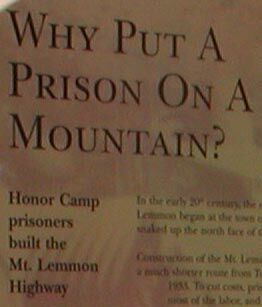| Start at the beginning |

|

|
 ...maybe because you can force wrongly detained people to build it for you?
...maybe because you can force wrongly detained people to build it for you?
|
|
Excerpt:
Why Put a Prison on a Mountain?
In the early 20th century, the only road to Mt. Lemmon began at the town of Oracle and traveled up the north face of the mountain. Construction of the Mt. Lemmon Highway, a much shorter route from Tucson, began in 1933. To cut costs, prisoners supplied most of the labor, and a "Federal Honor Camp" was built here in 1939 to replace the temporary prison camps along the route.
At first, prisoners had only picks, shovels, and wheelbarrows to use. "Before I went to the Honor Camp, I thought prisoners only broke rocks with picks in cartoons," one former prisoner recalls. Roadwork progressed faster when jackhammers, bulldozers, and tractors were brought in.
A Prison Without Bars
There were no fences or guard towers at the camp: a painted white line marked the camp boundary. Prisoners lived in wooden barracks near the creek. Besides constructing the highway, prisoners built the rock walls and poured the foundations for administration buildings and the guards’ quarters and grew much of their own food at a farm located near the base of the mountain.
After the Mt. Lemmon Highway was completed, the prison site hosted a series of youth rehabilitation camps until it closed in 1973. The buildings were removed in the 1970s, and today the ``prison camp'' is one of many recreation sites maintained along the Mt. Lemmon Highway by the Coronado National Forest.
Who were the Prisoners?
Some prisoners had been convicted of breaking tax or immigration laws. Many had refused to join the military for moral or religious reasons. These conscientious objectors included Hopi Indians from northern Arizona and Jehovah's Witnesses. Some of the prisoners were citizens protesting the internment of Japanese Americans during World War II.
|
| |
|